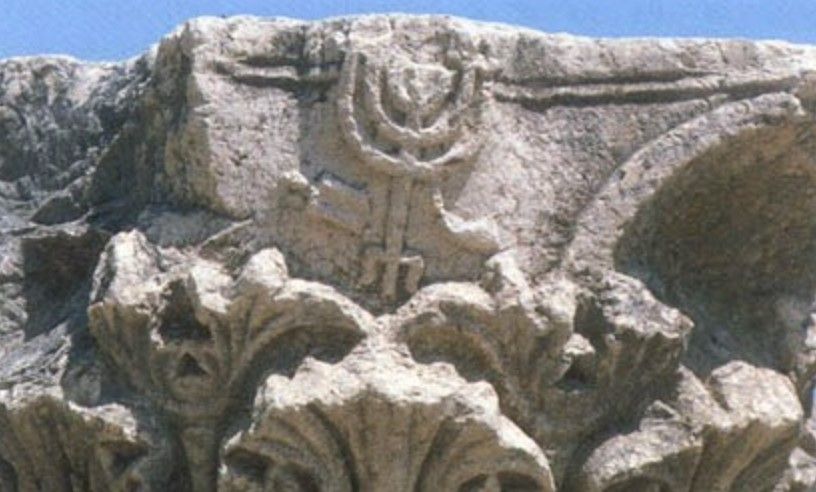


|
|
|
|||||||||||||||
|
|
||||||||||||||||
|
|
|||
|
|
Capernaum Synagogue †
Located in Capernaum, which is the remains of a village dating from the 2nd-century BCE to the 11th-century AD when it was abandoned. Archaeological evidence suggests that the site had no defensive wall and its location on the northern shore of the Sea of Galilee indicating its role as a fishing village. The site has a number of mentions in the New Testament and records that Jesus taught in the synagogue and also carried out a number healings there, however, the current synagogues is not the same as that which existed in Jesusís time, although it was built on the same site. 200 meters north of the synagogue is a cemetery, and a church built by the Byzantines is believed to have once been a house that was the home of Saint Peter. The ruins were discovered by American explorer Edward Robinson in 1838, who identified them as a synagogue, one of the oldest synagogues in the world, although he did not relate the site to ancient Capernaum. It wasnít until 1866, that the site - which was known at the time as Tel Hum - was identified as the location of Capernaum during a survey by the British cartographer Captain Charles William Wilson. The synagogue that exists today is believed to have been built around the 4th or 5th-century although was partially reconstructed in 1926, the actual dating of the Capernaum synagogue however, continues to be a matter of debate. † The very grandeur of the building has contributed to the controversy concerning the actual dating although various theories have been proposed. One of which is for a 4th-century date evidence for which is based in part on coins and pottery found beneath the floor. Although those that suggest an earlier 2nd-century date suggest that these may have been left during later repairs and reconstruction, possibly following the earthquake of 363. It has been suggested that the synagogue was destroyed in the early 7th-century probably prior to the Arab conquest in 636. Although it has also been suggested that it was destroyed as an act of retaliation around 630, following the re-establishment of Byzantine rule after the Persian invasion of 614. The foundations of a previous building have been found to lie beneath the foundation of the current synagogue, which it has been suggested was the foundation of a synagogue from the 1st-century. This is mentioned in the New Testament and is believed to have been financed by a Roman centurion who was based there. The only other known synagogues for this period were found Herodium, Gamla, Magdala and Masada. The foundations of the 1st-century Synagogue, where Jesus preached, is out of square and not level. The fact that the later building utilized these foundations may be in part due to saving costs but also it may suggests its historic importance and that it was saved as a memorial to the ancient first century synagogue. The 4th-century synagogue was built on a platform, on basalt stone foundations two meters above the houses of the town, and separated from them by streets on all four sides. Constructed of large, white limestone blocks from the hills of Galilee west of the town and ornate columns. The floor plan of the synagogue is rectangular in shape and was positioned so that on entering the worshipers face Jerusalem. The Capernaum synagogue is similar to the 4th-century synagogue at Chorazim (Korazim, 4 km to the north), and the 3rd-century synagogue at Baríam (in northern Galilee), but the architectural ornamentation of the Capernaum building is far more elaborate, with Corinthian capitals and intricately carved stonework with reliefs that include vine and fig leaves, geometric designs, and eagles. There are also carvings of five- and six-pointed stars and of palm trees. †  One relief carving of a cart may depict a portable Ark of the Covenant. Visitors are sometimes disconcerted by the fact that the architectural decoration also includes swastikas; although this was an ancient religious and cultural symbol and a common geometrical design of the period, which was adopted by the German Nazi party. The building itself is believed to have been two stories and consists of several parts: the praying hall, the western patio, a southern balustrade, and a small room at the northwest of the building, and the eastern atrium or the courtyard. † The praying hall measured 24.40 m by 18.65 m, with the southern face looking toward Jerusalem. The internal walls were covered with painted plaster and fine stucco work which was found during the excavations. It was suggested that there had been an upper floor reserved for women, with access by means of an external staircase located in the small room. But this has not been substantiated by the later excavations of the site. Within the synagogue are two inscriptions, one in Greek and the other in Aramaic, that commemorate the benefactors that helped in the construction of the building. Restoration work of the synagogue began in 1926 but was curtailed upon the death of the person in charge of the work; it was not to continue until 1976. † |
|
|
|
|
|||
All Photographs were taken by and are copyright of Ron Gatepain
| Site Map |